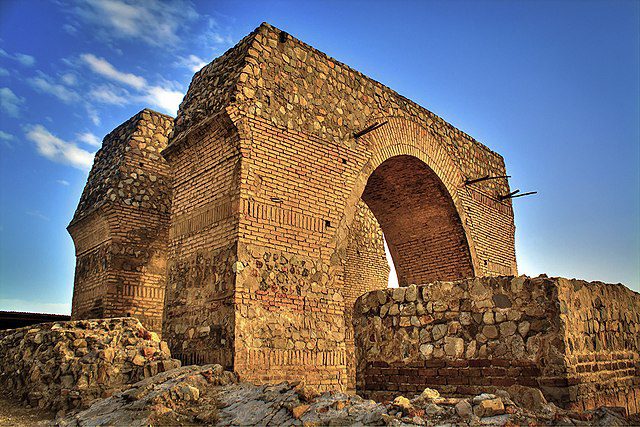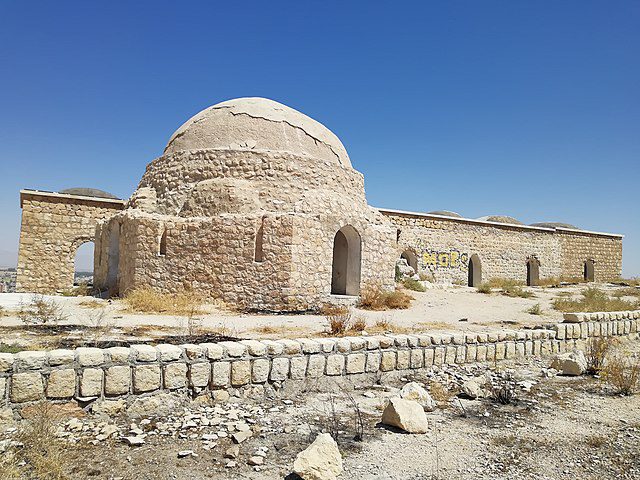Table of Contents
Deep within Iran, ancient temples stand as witnesses to a civilization that has lasted for thousands of years. Iran, one of the world’s oldest nations, has a rich history of believing in one God. These Iranian temples, made with care and skill, are like windows to a time when faith was an important part of Iranian life.
These old buildings are more than just impressive; they hold the memories of people’s devotion from a very long time ago. Each temple, with its detailed designs and special symbols, gives us a look into how people in ancient Iran practiced their faith. Whether it’s the tall Zoroastrian temples that celebrated nature’s power or the beautiful mosques where people prayed, these special places take us back to a time when faith was very important.
When you visit these Iran ancient temples, it’s like going on a journey to the past, where every step reminds you of the people who once believed there. These temples aren’t just old buildings; they’re living connections to Iran’s strong faith throughout history. Below, you will have the top Iran Temple List, from Zoroastrian fire temples to temples for other religions.
1. Naqsh-e Rustam
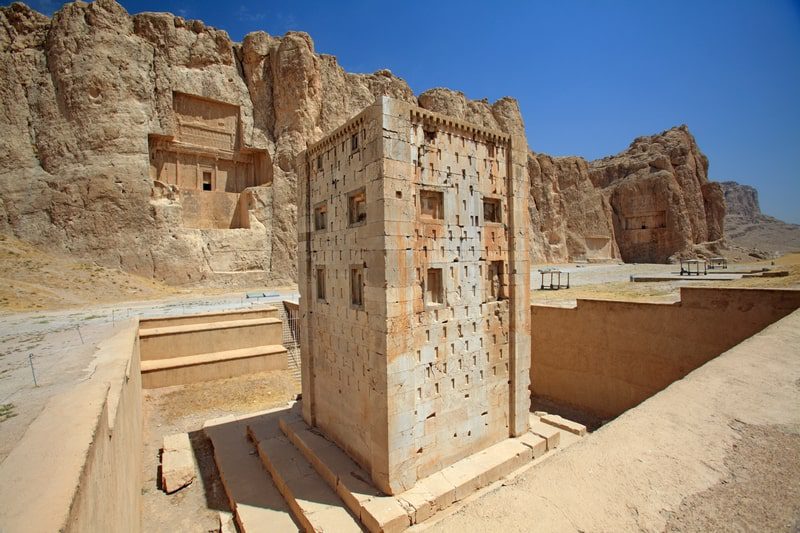
Naqsh-e Rustam Necropolis, nestled just six kilometers from Persepolis, is a remarkable Iran temple site with a rich history. It features cross-shaped rock-cut tombs, believed to hold the remains of ancient kings, including Darius I. Carvings above these tombs depict kings being blessed by divine beings. There are also enigmatic rock carvings that predate the tombs, hinting at an even older history.
In addition to the tombs, you’ll find the Ka’be-ye Zartosht (Cube of Zoroaster), a mysterious structure modeled after an ancient temple. Though its exact purpose remains uncertain, it exudes a sense of spirituality. Inscriptions in three languages on its walls add to the intrigue, offering glimpses into the past. Naqsh-e Rustam is a true treasure of Iranian heritage, inviting curious minds to uncover its secrets.
2. Anahita Temple
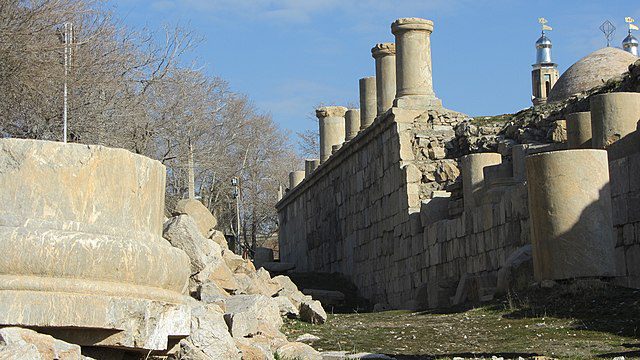
In Kangavar, there’s a remarkable relic perched on a high rock platform—an ancient Iran temple known as Anahita. This temple is named after a deity linked to water and blessings. While its exact age is debated, it’s believed to have roots in the Parthian era and shows signs of both Parthian and early Islamic influence.
The Anahita Temple Iran is a massive quadrilateral structure with thick, imposing walls measuring 230 meters in length. Its staircase, attached to the wall, resembles the stepped design seen in Achaemenian architecture. Below the temple’s eastern wall lies a cemetery from the Parthian era, where the buried faced the temple, emphasizing its historical importance. This temple stands as a testament to the region’s rich and ancient heritage.
3. Chogha Zanbil Temple (Ziggurat)
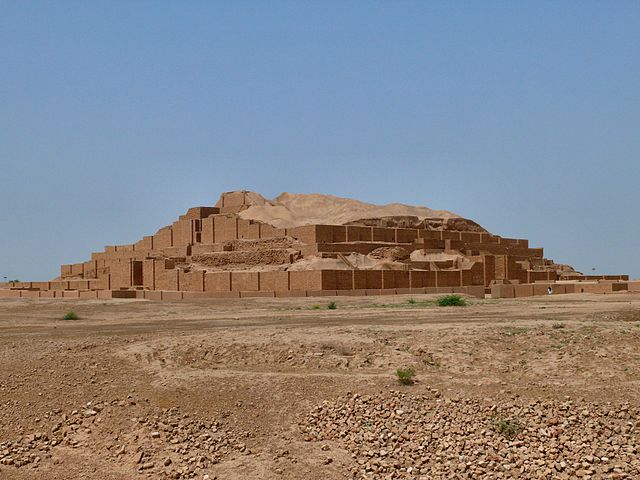
Nestled 30 kilometers southeast of Shoosh (Susa) and 80 kilometers north of Ahvaz in the Khuzestan province of Southwest Iran, Choqazanbil Temple, also known as Chogha Zanbil Ziggurat, stands as the solitary relic of an ancient city, a marvel born around 1300 BC under the reign of King Untash-Napirisha. Its primary purpose is to pay homage to the formidable god Inshushinak.
The name “Choga Zanbil” translates to “basket mound,” while its original moniker, “Dur Untash,” referred to it as the “town of Untash.” However, it’s likely that only a handful of individuals, primarily priests and servants, called this extraordinary city home. Situated approximately 2 kilometers from the Dez River, it was once known as “Ontashgal” (Dur Untash), marking an ancient cityscape whose significance endures through the ages. Choqazanbil Temple continues to evoke wonder and reverence as a testament to the grandeur of ancient civilizations.
4. Mitra Temple
A mere 15 kilometers from the bustling city of Qeshm, along the path from the ancient Kharbez vicinity to Bandar Sooza, lies one of the top Iranian temples adorned with captivating rocky architectural wonders, named Mitra Temple. Nestled within the heart of these mountains, one can find an extraordinary collection of rock formations, resembling cave-like openings, that grant access to this mystical site.
Beyond these openings, a vast space reveals itself, spanning 25 square meters and rising to an elevation of 2.7 meters, a product of human excavation. This intriguing chamber is believed to have served a special purpose—perhaps hosting solemn religious rituals for the departed or acting as a place of worship dedicated to ‘Izad Mehr’ or ‘Mitra.’ These echoes of the past harken back to the era of the Medes, offering a fascinating glimpse into ancient practices and beliefs. The Mitra Temple, hidden within these rocky confines, beckons explorers to delve into its mystical history and unearth the secrets it holds.
5. Qadamgah Temple (Badamyar)
Nestled in the heart of East Azerbaijan province, south of Azar-Shahr near the village of Badamyar, stands the remarkable Iran temple, Ghadamgah Mosque, formerly known as Qadamgah Temple. This Iran cave temple has withstood the test of time, boasting a history that spans over 1200 years.
The cave’s circular basement, with a generous radius of 15 meters, forms a unique architectural marvel. Its arched altar or mosque, dating back to the Safavid era, seamlessly blends with contemporary architectural styles. Today, this sacred Iran cave temple serves as a hub for religious ceremonies, a testament to its enduring significance in the lives of those who visit.
Located upstream of Ghadamgah’s graveyard, near the village of Badamyar, this Iranian temple was once during pre-Islamic times. With the advent of Islam, it transformed into a mosque, where villagers and tourists alike gather to partake in religious observances, particularly during the holy months of Muharram and Ramadan. The Ghadamgah Mosque, steeped in history and spirituality, continues to be a cherished place of reverence and reflection for all who come to visit.
6. Varham Fire Temple
Yazd is a city where various religions peacefully coexist, evident in its diverse religious buildings such as Iran temples. At its core stands the Zoroastrian Fire Temple of Yazd, Varham Fire Temple, a symbol of this harmony, just a short walk from the grand Yazd Grand Mosque.
Today, we’d like to introduce you to one of Yazd’s Zoroastrian religious sites, a must-visit for many travelers. The temple’s doors are open to everyone, a gesture of cultural sharing by the Zoroastrian community. Built during the first Pahlavi dynasty, the Yazd Varham Fire Temple holds deep meaning for Zoroastrians and is also known as the Fire Temple of Verheram, home to the sacred fire of Varheram.
Since the 1960s, this place has welcomed visitors, serving as a bridge between cultures and religions. Its recognition on Iran’s National Heritage List since September 13, 1999, underscores its importance as a historical and cultural gem. Stepping inside, you’ll journey through time, discovering the rich blend of beliefs and traditions that have thrived in Yazd for centuries.
7. Adrian or Adorian Fire Temple
Founded in 1913 along Jomhori Street, the Adrian Fire Temple in Tehran is a testament to the enduring legacy of the Qajarid era. This cherished Iran temple serves as a sacred space for special ceremonies, including weddings and memorials, keeping alive the traditions of the old.
As you step into the temple’s courtyard, you’re greeted by a sizable pool that mirrors the architectural layout found in the temples of Yazd. This design pays homage to the timeless traditions and architectural grace of Iran’s religious heritage, offering visitors a tranquil and evocative glimpse into the past.
8. Khorheh Solooki Temple
Nestled to the west of the busy Tehran-Isfahan Road lies the historical Khorheh Village, a place steeped in the past. But what truly sets this village apart is the archaeological treasure from the Seleucidian era that graces its western horizon. Dating back to the 4th or 3rd centuries BC, this remarkable relic, likely once a sacred temple, is now represented by two towering stone columns, standing at a formidable height of 6 meters.
This ancient Iranian temple holds immense historical value, and according to the studies of ‘Hertsfold,’ it may have been dedicated to the ‘God of War.’ Today, lush vineyards embrace the temple’s surroundings as it gazes out over the southern plains, with the gentle flow of the Khorheh River nearby. The fortifications and columns, remnants of a grand structure, likely took shape an astonishing 23 centuries ago.
Recent excavations in this historic vicinity have unveiled intriguing details about the temple’s layout. To the south, the original structure reveals columns, chambers, and a courtyard, while the northern section, the primary one, boasts chambers and corridors. The western part comprises additional chambers and a hall. Adding to the allure of the site, a mineral water spring with ample water capacity flows near this ancient marvel, offering a refreshing link to the past in this captivating corner of history.
9. Bard Neshandeh Temple
In the heart of ancient Iran, Bard Neshandeh stands as a testament to the religious rituals of yesteryears, conducted in an expansive open area. This venerable site is a blend of Parsee and Achaemenian architectural influences, with intricate stone carvings harking back to the Parthian era.
Notably, the excavation of this sacred Iran temple yielded a remarkable treasure—a statue of “Heraclitus” or “Hercules,” towering at over 2 meters in height. The Bard Neshandeh vicinity unfolds in three distinct segments: a palace, an eastern worship area adjacent to it, and residential quarters situated to the north.
Beneath its ancient soil, valuable historical relics have been unearthed, many of which find their home in local and international museums. Among these precious remnants, you’ll discover ancient statues, coins, and earthenware, each holding a piece of Iran’s storied past. Bard Neshandeh Temple, a window into antiquity, offers a captivating glimpse into the rich history and spiritual practices of ancient Iran.
10. Kalat Temple
Nestled high in the ‘Mond’ Mountains, just 30 kilometers from Khormoj, the Kalat Temple beckons with its intriguing architecture. This ancient Iran temple boasts a central platform topped by an elegant arched roof and flanked by two entrances, all adorned with ten decorative sutures.
Venture into its lower chambers, and you’ll find a peculiar sight—wells that hint at a long-forgotten purpose. Were they resting places for the deceased or cryptic sanctuaries for ancient remains? The Kalat Temple is a captivating puzzle, inviting you to uncover its timeless secrets.
11. Hindus Temple (Indians Temple)
You don’t have to travel to India to see a beautiful Indian-style temple. In Bandar Abbas, there’s a historic gem called the Hindu Temple. It was built in 1892, during the rule of Mohammad Hassan Khan Sa’d-ol-Malek, with contributions from Indian merchants.
The Iran temple’s unique dome with 72 turrets stands out and is considered one of Iran’s most beautiful. Inside, you’ll find a lovely quadrangle-shaped room with pretty frames and four corridors. On the eastern side, there’s a big hall where different Indian beliefs are represented in paintings. Although some paintings need restoration, they still showcase the temple’s connection to India’s culture. So, if you’re in Bandar Abbas, make sure to visit this Indian-inspired architectural wonder.
12. Azargoshnasb Fire Temple
In Western Azerbaijan, you’ll find the Azargoshnasb Zoroastrian temple, a place of great importance in ancient Iran before Islam. This Iranian temple was dedicated to Zoroastrian rituals for the military classes during the time of the Sassanid dynasty. The Sassanid kings considered it so holy that they visited it right after becoming kings. However, the temple faced destruction when the Roman Emperor Heraclius attacked Iran in 624 AD.
After the arrival of Islam, people began to believe that this Iran temple’s location was the throne of King Solomon. That’s why it’s now called Takht-e Soleiman. This change in belief shows how the temple’s history and faith have intertwined over time, leaving behind a captivating story of transformation.
13. Ardeshir Fire Temple
Nestled near Firouz Abad city in Fars province, the Ardeshir Fire Temple, also known as Ardeshir Castle, is a reminder of Ardeshir, the Sassanid king. This Iran temple takes its design cues from the ancient Achaemenid and Parthian castles and fire temples.
Ardeshir Castle is a captivating sight with its three domes, ornate plaster columns, spacious halls, arch chambers, a courtyard, and many rooms. While time has left its mark on this place, it remains one of the best-preserved historical sites from the Sassanid dynasty.
Exploring Ardeshir Fire Temple is like stepping back in time, where you can hear the echoes of history and imagine the grandeur of ancient Iran.
14. Kashmar Fire Temple
As the oldest Zoroastrian Fire Temple, Kashmar Fire Temple has a unique place in history as the first-ever Zoroastrian fire temple. This Iran temple was built by Vishtaspa in response to Zoroaster’s request in Kashmar. According to the story in Ferdowsi’s Shahnameh, after Vishtaspa embraced Zoroastrianism, he sent priests around the world, and the first fire temple, Adur Burzen-Mihr, was established in Kashmar. A cypress tree was planted there, symbolizing the acceptance of the Bahi religion. The temple became a gathering place for famous individuals.
During the Sasanian Empire, Kashmar was part of Greater Khorasan, and the Sasanians worked diligently to revive the ancient Zoroastrian religion. Today, a few kilometers above the ancient city of Kashmar, within the Atashgah castle complex, the legacy of the Kashmar Fire Temple still stands, reminding us of its significant role in shaping the religious and cultural history of its time.
15. Mehri Temple
In the village of Varjooy, located just 6 kilometers southeast of Maraqeh, lies a hidden gem—the Varjooy Temple. Unlike many Iran temples, this ancient structure is uniquely subterranean, nestled below ground level and accessible through a single entrance.
Throughout its history, particularly in the 8th century AH, this historical Iran temple underwent certain architectural modifications. Today, it stands as a priceless relic, celebrated for its artistic and engraved treasures. The Varjooy Temple, with its enigmatic underground presence, serves as a testament to the enduring allure of ancient architecture and craftsmanship.
16. Baba Abbas Temple
In the southwest of Khoram Abad, a mere 8 kilometers from the Khoram Abad – Koohdasht Road, lies a crypt shrouded in mystery within ‘Baba Abbas’ Valley. This intriguing Iran temple, unfortunately, located within a protected military area, boasts an array of captivating features.
Surrounding the crypt, you’ll discover a collection of columns and four sturdy stone walls. To the west, stone steps ascend the mountain’s slope, leading to an open space that resembles a sacrificial area. This elevated space rests 20 meters above the crypt, adding to the site’s mystique.
Once serving as a temple for sun worshippers, the crypt bears witness to ancient beliefs and practices. Notably, nestled within the Baba Abbas Valley, you can also find the tomb of Mama Jalaleh, the mother of Shah Khusheen, adding to the historical tapestry of this intriguing locale.
17. Parthian Temple
In the northern vicinity of the Dariush engraving at Bistoon, a remarkable piece of history awaits discovery—the remnants of a Parthian-era structure. This ancient Iran temple, was erected during the Parthian period, aligning with the construction of another relic in Bistoon.
The Parthian temple, positioned opposite the Parthian impressions slab, consists of two distinct platforms connected by ten irregularly arranged steps, leading all the way to the Valgash inscription. Resting atop the upper platform, you’ll find a finely sculpted stone brazier. In the surrounding slopes of Bistoon Mountain, traces of Parthian-era earthenware have been unearthed, providing further insights into the historical significance of this location. The Parthian Temple stands as a testament to the rich cultural and religious heritage that once graced this storied landscape.
18. Chahar Tagh Fire Temple
In the picturesque Niasar village, just 28 kilometers to the west of Kashan city, stands the remarkable Niasar Fire Temple, affectionately known as Chahar Tagh. This sacred structure, perched atop the village’s highest point, boasts a distinctive dome and an intriguing chamber.
This Iran temple’s chamber is an open space, lacking walls on all four sides, yet it emanates a profound sense of spirituality. Crafted from stones carefully bonded with mortar, the lower section of the temple features regular stones, while the arches and upper portions are adorned with square-shaped stones. This architectural blend of simplicity and sophistication gives the Niasar Fire Temple its unique character, inviting visitors to explore the ancient traditions and history it holds within its stone-crafted walls.
19. Tappeh Mill or Bahram Fire Temple
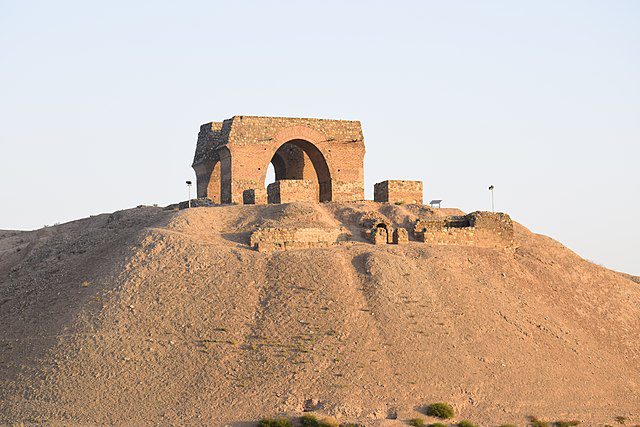
Tappeh Mill, also known as the Bahram Fire Temple, is among Iran temples for Zoroastrians, perched atop a hill near Ghal’eh Noe Village, not far from Rey, south of Tehran.
Though experts debate its age, some say this Iran temple dates back to the Sassanid era (224–651 CE), while others believe it might stretch even further to the Achaemenid era (550 BC–330 BC) before Alexander the Great’s conquest. Inside, you’ll find a spacious hall divided into three parts, with the sacred fire once burning in the eastern part under a grand vault and four columns. Despite the centuries that have passed, intricate plaster patterns and images of plants and animals still adorn its walls, reflecting the temple’s enduring historical charm.
20. Pir-e-Sabz Fire Temple
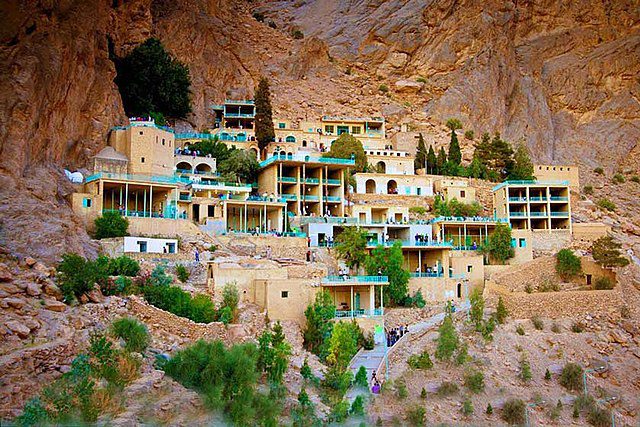
Nestled near Ardakan County in Yazd province lies the village of Chak Chak, also known as Pir-e-Sabz, a cherished Iran temple for Zoroastrians. This sacred haven includes the Pir-e-Sabz Fire Temple, perched upon the mountain, drawing devotees from far and wide for an annual religious festival held in June.
Zoroastrians, when visiting the Yazd Fire Temple, traditionally don white or light-colored clothing. However, tourists are welcome to explore this attraction without the attire requirement. Within its hallowed walls, a flame has flickered since 470 AD, a testament to the enduring spiritual legacy of Zoroastrianism.
FAQs about Iran Temple List
Q1: Does Iran have temples?
A1: There are still many exquisite fire temples in Iran that you can visit today. Some of these include the Atashgah Fire Temple in Isfahan, the Sarmasjed Mosque in Khuzestan, Takht-e Rostam in Tehran, Kirkuk in Sistan & Baluchistan province, and the Bahram Fire Temple in Yazd, where a flame has been continuously burning for 1500 years.
Q2: Which temple is famous in Iran?
A2: The Lord Vishnu Temple in Bandar Abbas, Iran, is an old building made in 1310 AH (1892 AD) when Mohammad Hassan Khan Sa’d-ol-Malek was in charge. This temple is devoted to Lord Vishnu.
Q3: Did Persia have temples?
A3: Even though Herodotus said Persians didn’t have temples, some have been discovered. They look like terraces, towers, or square rooms. Chahārtāqs, which are sacred buildings with four gates or doors, are found all over Iran. There are also fixed altars from the Sasanian era, and they are shown on coins with a burning fire.
Q4: Are there Hindu temples in Iran?
A4: The Arya Samaj constructed two Hindu temples, one in Bandar Abbas and another in Zahedan, with financial support from Indian traders during the late 1800s. In 1976, A.C. Bhaktivedanta Swami Prabhupada visited Tehran.
Q5: Are there fire temples in Iran?
A5: The Fire Temple of Takht-e Rostam is an ancient temple from the Sasanian Empire, situated in Shahriar County, Tehran Province. Similarly, the Fire Temple of Tashvir is another historical temple from the Sasanian Empire, found in Tarom County, Zanjan Province.
Q6: What is the most famous Zoroastrian temple?
A6: The Fire Temple of Yazd, also called Yazd Atash Behram, is a Zoroastrian temple located in Yazd, Yazd province, Iran. This temple houses the Atash Bahram, which translates to “Victorious Fire,” and it has been preserved since the year 470 AD.
Q7: Do Zoroastrians believe in God?
A7: Zoroastrians have faith in the idea that their religion was disclosed by their highest God, known as Ahura Mazda, also referred to as the ‘Wise Lord,’ to a priest named Zarathustra (or Zoroaster, as the Greeks called him).
Unlock the Mystique of Iran’s Temples with Customized Tours
Exploring the rich Iran temple can be a profoundly enriching experience. However, to truly savor the best of what this ancient land has to offer, it’s often recommended to embark on a journey through customized tours.
One exceptional solution for those seeking to unravel the secrets of Iran’s temples is To Iran Tour. As a leading provider of Iran tours and travel packages, To Iran Tour specializes in crafting personalized journeys that cater to the unique desires and interests of each traveler. We understand that your trip to Iran is not just another vacation; it’s an opportunity to immerse yourself in the rich history, spirituality, and architecture of this captivating nation.
Contact To Iran Tour today, and let’s embark on an Iran temple exploration journey together! Your adventure awaits, and we’re here to make it extraordinary.

